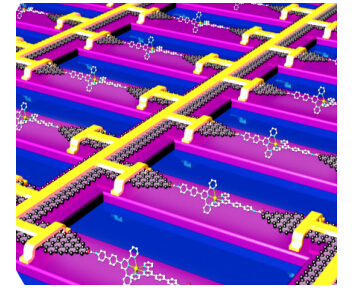Integrating individual molecules into electrical circuits, often termed as “Molecular Electronics”, is currently a focus research area because it can not only meet the increasing technical dem and s of the miniaturization of traditional Si-based electronic devices, but also provide an ideal window of exploring the intrinsic properties of materials at the molecular level. Indeed, over the past decade we witnessed the significant progresses achieved in both experiments and theory for the purpose of constructing, measuring, and underst and ing the electronic and photonic responses of these conceptually simple molecular junctions in which molecular systems play an important role as pivotal elements [1,2]. These advances have attracted researchers from a variety of backgrounds and begun to move beyond simple descriptions of charge transport and branch out in different directions, reflecting theinterdisciplinary realm.
From the basic scientific point of view, the major question in the field of molecular electronics is “how do electrons move through molecules”. Underst and ing electron movements through a single molecule is central to the field, but presents a significant experimental and theoretical challenge. The first theoretical work in the history of molecular electronics was published in 1974 by Aviram and Ratner [3]. This important work discussed transport through a single molecule, suggesting that a single molecule when s and wiched between two electrodes could act as a device (such as a molecular rectifier). However, the most important problem was how to attach electrodes to a molecule. After over two decades, the first significant report attempting to measure single-molecule transport came from both Mark Reed’s group and James Tour’s group [4]. Their collaborative works fostered better underst and ing of how such measurements could be done and provided insights about charge transport properties of individual molecules. This was regarded as the true beginning of molecular electronics [5]. The success of these early demonstrations ignited broad interest worldwide, and led to an explosion of research in the field. So far, discrete approaches have been developed for molecular junction fabrication, including break junctions, scanning probe techniques, s and wich electrodes, lithographic methods, mercury drop electrodes, and so on. These single-molecule junctions became more robust, reliable and reproducible. Concurrently, theoretical methods based on Green’s function theory have been developed to allow researchers to explore the intrinsic properties of single molecules under non-equilibrium condition. Both experimental and theoretical achievements have opened up the unlimited opportunities to investigate novel effects of materials at the molecular level and discover potential applications, such as molecular spintronics, molecular plasmonics, thermoelectrics, quantum interference effects, time-evolution of the phenomena and single-molecule detection, only some of which have recently been investigated.
For practical application, creating useful electronic devices that use molecules as the active element requires atomic-scale precision fabrication and long-term stability [6]. Grafting a single molecule in a device is not an easy task, and to do so reproducibly is an even more difficult one. Therefore, the main challenge in molecular electronics is to find efficient ways to reduce device variability and even shift the focus from the molecule/electrodecontact interface to molecular functionalities themselves [7]. Statistical approaches [8,9,10] can not solve the reproducibility and control issues faced in molecular electronics. All technologies that aim to develop electronic devices scaled to the ultimate limit need a degree of control with atomic accuracy (for example atomic-sized electrode fabrication and atomic contorl of contact geometry). The second impelling challenge originates from an intrinsic misalignment between the discrete molecular energy levels and the continuous metal states of the electrodes. To align the Fermi energy with either HOMO or LUMO of molecules, three-terminal device architectures are needed. In addition to sorce/drain electrodes, gate approches, although challenging, could allow effic ient fine-tuning of energy-level alignment, and enable study of quantun transportat the single-molecule level. Finally, for future computing systems where molecualr components will substitute conventional semiconductor analogues (only partially on a chip), several additional formidable challegnes will hamper the rapid development of molecular electronics, including CMOS-compatibility, power dissipation, and integration capability. The exciting aspects of molecular devices are the miniaturized dimensions with wide-ranging functionalities and the high degree of control on molecular design possible through chemical synthesisthat are difficult to achieve by solid-state technology at present. Hopefully, thesetechnical limitations will be overcome with enough focus, innovation and resources.
Considering the fundamental issues discussed above, carbon-based electrodes, like carbon nanotubes [11] or grapheme [12], seem a promising approach (Figure 1), because having molecules and electrodes of the same material (carbon atoms) considerably reduces the electronic mismatch at the molecule/electrode interfaces. In particular, graphene is a remarkable material with extraordinary electronic and structural properties. Its high mobility, the structural stability and the easy availability at the wafer scale with high quality through bottom-up approaches make it useful as CMOS-compatible electrodes in molecular electronics. Another important feature of carbon-based materials is their richness in chemical activities, which can afford well-defined molecule/electrode contact interfaces through robust covalent formation. The works from our group and others have positioned carbon-molecule junctions as a new-generation testbed for molecular electronics [7,13,14,15,16,17].
Obviously, the field of molecular electronics has become a fascinating playground for scientists for exploring new fundamental concepts. Its success highly depends on the continuous willingness of chemists, physicists, materials scientists and engineers to work together. However, molecular electronics is a vibrant and dynamic area of science and technology, and many surprises are in store from the front.
Acknowledgements
The work reported here is supported by MOST (2012CB921404) and NSFC (21225311, 21373014 and 91333102).










 DownLoad:
DownLoad: 


